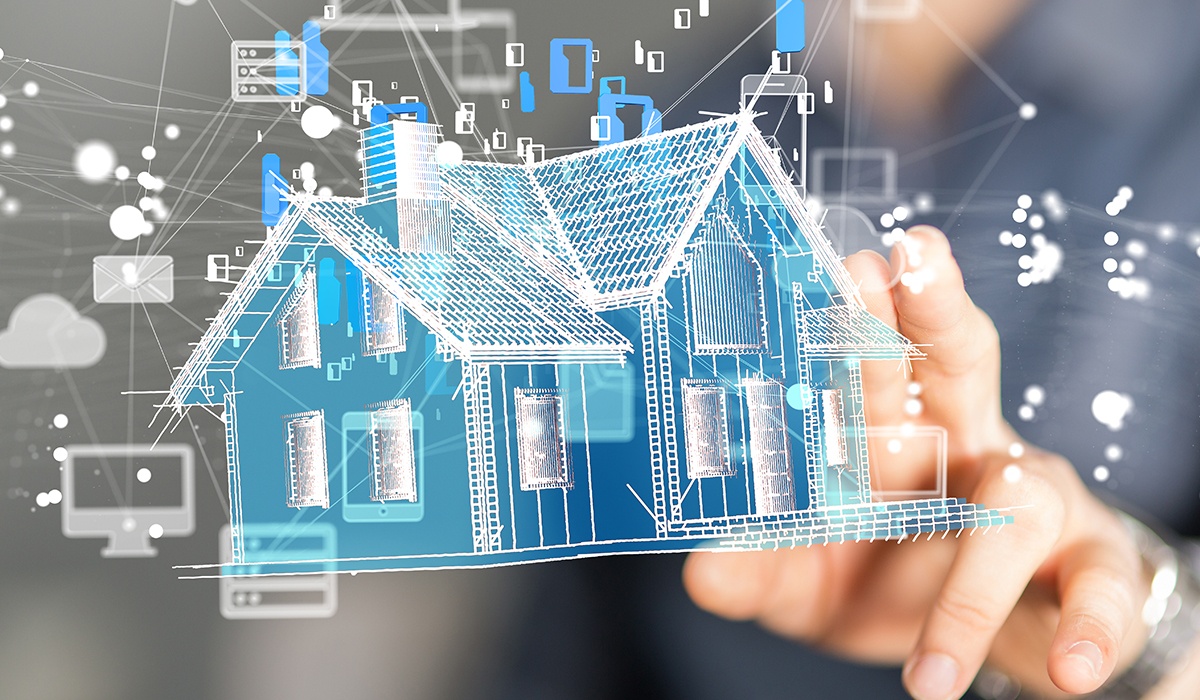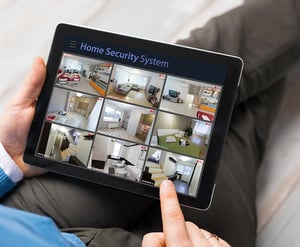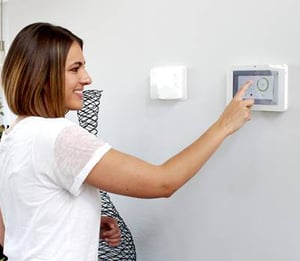Smart Homes:
What to Know

Smart home automation features remotely controlled and interconnected devices, such as alarm systems, security cameras, lights, thermostats, and more—all of which improve safety, increase convenience, and enhance efficiency—from any mobile device.
Smart home automation features remotely controlled and interconnected devices, such as alarm systems, security cameras, lights, thermostats, and more—all of which improve safety, increase convenience, and enhance efficiency—from any mobile device.

Editor’s Note: This resource guide was originally published in October 2018 and was revised in February 2023 to reflect industry updates and new technologies.
Smart homes are residences equipped with interconnectable technology enabling users to control key household features, such as lighting, temperature, security, and more. Managed and automated through compatible mobile devices, this increases safety and efficiency, streamlines communications, and enhances everyday activities.
According to online market and consumer data platform Statista, 57 percent of U.S. consumers are expected to add smart technology to their homes by 2025.
From controlling lighting to safeguarding doors and windows, checking in on loved ones, and other wellness benefits, smart automation personalizes the home experience, while saving energy and money.
This comprehensive guide discusses many smart home aspects, including its evolution, key characteristics, benefits, and more.
Smart Home Evolution
Technology continuously transforms the way we live. Consider the invention of everyday appliances, such as vacuum cleaners, washing machines, dishwashers, HVAC systems, and microwaves. While these may now seem basic, they were once considered high-end, technologically advanced products.
Those we currently consider smart devices and homes weren’t developed until the late 20th century. Technology significantly advances each year, and devices such as smartphones, tablets, and laptops are now common in nearly every household.
The 1999 TV movie Smart House accurately predicted how current smart technologies would operate—with voice commands adjusting temperatures, sending alerts, and controlling lighting.
Smart homes are expected to further evolve in the coming years, with more and more homeowners adding these compatible technologies for safety, security, and convenience.
A report conducted by consumer market research firm Strategy Analytics predicts smart home system spending will exceed $170 billion by 2025.
What Is a Smart Home?
Designed to save time and money for home security and safety, smart homes can remotely automate everyday tasks via Wi-Fi. Imagine being able to close and lock garage doors, dim lights, or adjust interior temperatures from any mobile device, regardless of your location. You can even power down appliances and electronics for energy efficiency, or if you forgot while rushing out.
Smart technologies can also track health and wellness goals concerning exercise, nutrition, and scheduled medications, among others.
Whether you’re adding or upgrading this technology, it’s best to work with a provider partnered with a reputable smart technology company, such as Alarm.com.
Connected Smart Home Devices
There are various feature-rich, smart products currently available for home installation through services providers such as General Security.
Note the following smart technologies:
Alarm Systems
These new and improved versions of standard security systems provide real-time alerts for everything from children arriving home from school to triggering or disarming an alarm. Smart security systems also enable homeowners to remotely monitor and control activities from any mobile device.
Security Cameras
Installing smart security cameras in and around your property enables you to view real-time footage from anywhere. Such systems are compatible with home automation hubs, for additional integrations.
Consider the following indoor, outdoor, doorbell, and wellness security cameras:
Indoor/Outdoor
Wired or wireless cameras include night vision, in-app video feeds, motion detection, and two-way audio. Camera motion settings can also be adjusted for accurate video analytics and monitoring.
Doorbell
These provide contactless, front-porch communication to remotely instruct a delivery person to leave a package, food, or other items on your doorstep—whether you’re home or away.
All Alarm.com-branded doorbell cameras are equipped with front-porch identification, intelligent lighting integration, and nighttime detection.
Wellcam
Available through General Security’s Wellness packages, Wellcam features real-time, two-way audio and video communication. These cameras can also easily connect to Personal Emergency Response Systems (PERS) for additional monitoring and fall detection alerts, even if its panic button is out of reach.
Not all security systems and cameras are smart-compatible, so it’s best to work with a services provider such as General Security for assistance.
According to online market and consumer data platform Statista, 57 percent of U.S. consumers are expected to add smart technology to their homes by 2025.
Smoke Alarms & Carbon Monoxide Detectors
It’s not just intruders who could threaten your home’s safety—fires and carbon monoxide are also potential hazards. Smart capabilities provide real-time alerts of these dangers, protecting you and loved ones from potential loss of life and property. These devices also deliver real-time alerts indicating low or missing batteries.
Thermostats
Rather than waiting to change interior temperatures when you’re at home, smart thermostats can be remotely adjusted, and self-regulate based on weather reports.
Energy Management
If you forgot to turn lights off before leaving the house, you can still prevent energy loss and high electric bills with smart light switches, dimmers, and LED bulbs.
Add smart outlets to manage auto shut-off for electronic devices such as TVs and gaming systems.
Sprinklers
A smart sprinkler system can handle more than just lawn maintenance. Similar to smart thermostats, these devices can adjust schedules based on local weather reports, which is especially useful during seasonal changes. It can also modify usage according to soil type, sun exposure, and other factors.
 Leak Detection & Flood Sensors
Leak Detection & Flood Sensors
Protecting your home from leaks, moisture, and water damage is another smart feature. Receive real-time mobile alerts through your system’s leak detection and flood sensors to avoid costly damages before they happen.
Consider adding the Alarm.com Smart Water Valve + Meter for quick leak and moisture identification, and automatic shutoff. These are also helpful diagnostics for secondary or seasonal homeowners who might not be onsite.
Wellness
Checking in on elderly loved ones when you can’t be there provides peace of mind and reassurances they’re safe while living independently.
Using real-time sensor data and algorithms to identify your loved one’s regular patterns, General Security’s Wellness system recognizes unusual activities that could lead to emergency events, such as nighttime slips and falls, lapsed medications, poor eating habits, inconsistent sleep patterns, and more. Open/close sensors can also be placed on kitchen cabinets, refrigerator doors and bathroom medicine cabinets for nutrition and medication schedule insights.
Appliances
Smart stove and grill guards can be implemented for automatic shutoff. This provides real-time monitoring for dangers such as leaving on a hot stove, grill, or oven—all of which could lead to fires, gas leaks, and propane loss.
Smart Locks
Manage efficiency and security with smart door locks whether home, away, or about to pull into your driveway. Mobile alerts notify if you’ve left doors unlocked, or if they’ve been opened by an unapproved user.
Glass Break Sensors
Also referred to as glass detectors, these notify homeowners if a glass window and/or door is broken. Unlike traditional sensors, they activate with noise or shattered glass vibrations.
When combined with contact sensors, this technology provides the highest level of real-time intruder protection.
Smart home devices are beneficial for every household—whether a family with small children and pets, or elderly loved ones living alone.
Smart Home Technology Benefits
Smart home devices are beneficial for every household—whether a family with small children and pets, or elderly loved ones living alone.
Integration & Interconnectivity
Although every smart device is helpful, integration and interconnectivity is what makes these truly remarkable and convenient for home safety and security management.
Remote Monitoring
Remote monitoring enables users to control any smart technology from anywhere—via mobile device assistance. This provides real-time check-ins on various home and property elements.
Motion Detection
Activated only when motion is detected, this technology saves time, battery life, memory, storage, and energy. Regardless of whether you’re home or away, it notifies of potential suspicious activities within and around your property.
Video Analytics
Perhaps one of the most standout features of smart home automation is video analytics. In line with motion detection, this advanced technology can be added as another security layer. Intelligent enough to differentiate between animals, humans and vehicles, it minimizes erroneous notifications and deciphers movement to help prevent false alarms.
Pre-programmed tripwires, activity zones, and responses—such as activating indoor/outdoor lights—trigger real-time alerts, warding off potential intruders.
Customization
Many smart home devices provide personalized functions to suit individual needs—deferring to behaviors and/or geographical locations.
Peace of Mind
Knowing what’s happening in and around your property, regardless of your location, helps ensure your family and home are always safe.
Geofencing Capabilities
Geofencing further enhances smart home security when integrated. Virtual fencing or borders can be customized via the Alarm.com app and remotely accessed to activate a pre-programmed stage or scene within 100 feet or less of a desired location—such as unlocking your garage door and turning on your living room lights as you pull into the driveway, for example.
Central Station Alarm Monitoring
Directly connecting to local law enforcement and emergency personnel for immediate, 24/7 response, Central Station Monitoring reduces the chances of injuries or even possible fatalities.
Smart Security Advantages
 There are several significant advantages to investing in a smart security system. Among these:
There are several significant advantages to investing in a smart security system. Among these:
Proactive Home Security Tools
Rather than reacting to a problem that has already occurred, smart security systems proactively help prevent break-ins and other dangerous incidents.
Monitoring More Than Just Your Home
Because smart security cameras can be installed throughout the home’s interior and exterior, users can monitor activities indoors and outdoors, such as mischievous pets, children arriving home from school, or elderly loved ones.
Maintaining Control
Remotely answer doors, activate and deactivate alarms, and operate other home security system components from any mobile device.
Saving Money & Energy
Controlling interior temperatures and lighting helps homeowners improve efficiencies and save on utility bills by optimizing usage during specific hours and powering down when nobody is home.
Improving Home & Property Values
Many home buyers incorporate smart features into their new living spaces and are willing to pay more for a property pre-equipped with these.
Rather than reacting to a problem that has already occurred, smart security systems proactively help prevent break-ins and other dangerous incidents.
Growth & Utilization
Smart security systems have developed into integral aspects of how today’s homeowners live, work, and socialize. It’s important you implement the ideal security solution to safeguard your loved ones, home, and property.
General Security offers smart home technologies to homeowners located throughout the U.S. East Coast. Request a free quote from us today!
